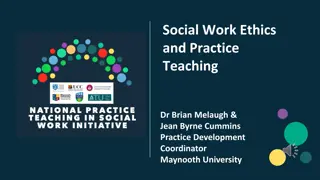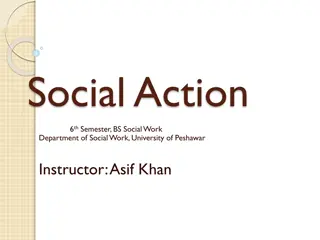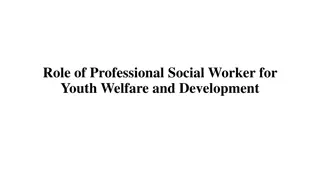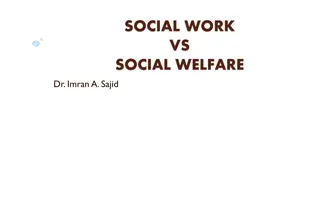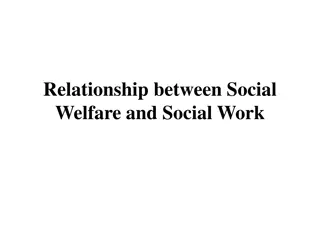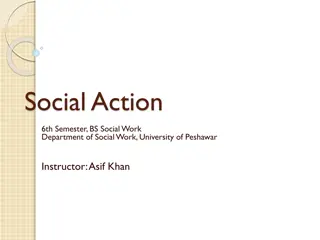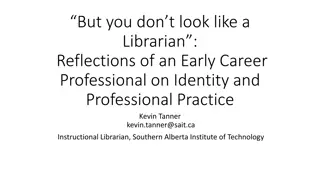Understanding the Concept of Social Action in Professional Social Work
Social action is a crucial method in professional social work that involves organized efforts to bring about structural changes in society or prevent adverse changes. It addresses social problems like the dowry system, environmental destruction, and health issues through mobilizing masses for impactful outcomes. The concept, definitions by various scholars, and objectives of social action contribute to its significance in social work practice.
Download Presentation

Please find below an Image/Link to download the presentation.
The content on the website is provided AS IS for your information and personal use only. It may not be sold, licensed, or shared on other websites without obtaining consent from the author. Download presentation by click this link. If you encounter any issues during the download, it is possible that the publisher has removed the file from their server.
E N D
Presentation Transcript
Social Action 6th Semester, BS Social Work Department of Social Work, University of Peshawar Instructor: Asif Khan
CONCEPT OF SOCIAL ACTION Social action is considered an auxiliary method of professional social work.As one of the methods of working with people,it has remained a debatable issue among the social work professionals. Social action is a method of social work used for mobilizing masses in order to bring about structural changes in the social system or to prevent adverse changes. It is an organized effort to change or improve social and Economic institutions. Some of the social problems like dowry system,destruction of natural resources,alcoholism, poor housing,health,etc.can be tackled through social action.
Contnd.. As a method of professional social work, social action has remained an issue with wide ranging of opinions regarding its scope, strategies and tactics to be used,its status as a method and its relevance to social work practice. Mary Richmond was the first social worker to use the word social action in 1922. She defines social betterment through propaganda and social legislation . action as mass
Definition(s) Baldwin (1966) defines social action as an organised effort to change social and economic institutions as distinguished from Social work or social service,the fields which do not characteristically cover essential changes in established institutions.Social action covers movements of political reforms,industrial democracy,social legislation, racial and social justice,religious freedom and civic liberty and its techniques include propaganda,research and lobbying Friedlander (1977) defines social action as an individual, group or community effort within the framework of social work Philosophy and practice that aims to achieve social progress,to modify Social policies and to improve social legislation and health and welfare services
Contd.. Wickendon,1956: social action is a term applied to that aspect of organised social welfare actively directed towards shaping,modifying or maintaining the social institutions and policies that collectively constitute the social environment. Moorthy,(1966): states that the scope of social action Includes work during catastrophic situations such as fires, floods,epidemics,famines,etc.,besides securing social legislation. Nanawati (1965) views social action as a process of bringing about the desired changes by deliberate group and community efforts.Social action does not end with the enactment of social legislation,but the execution of the policies was the real test of success or failure of social action .
OBJECTIVE OF SOCIAL ACTION The objective of social action is the proper shaping and development of socio-cultural environment in which a richer and fuller life may be possible (1992) has identified following goals of social action: 1) Prevention of needs; 2) Solution of mass problems; 3) Improvement in mass conditions; 4) Influencing institutions,policies and practices; 5) Introduction of new mechanisms or programmes; 6) Redistribution of power and resources (human, Decision-making;) 8) Effect on thought and action structure;and 9) Improvement in health,education and welfare. for all the citizens. Mishra
Six Characteristics of Social Action Talcott defined six characteristics of social action which are as follow. Actors who perform social action individuals. There is purpose or motive behind every social action. The motive can be achieved by actors from different type of actions. Actor achieve his goal by different means depends on the situation. The objective and means of achieving that are selected on the basis of norm,values and laws. Involving action actor use his personal perspective to take decisions regarding, the means to achieve his goal. are individual or
PRINCIPLES OF SOCIAL ACTION PRINCIPLES mobilization as a typical example of the direct mobilization model of social action Britto (1984) brings out the following principles of social action: 1.Principle of Credibility Building 2.Principle of Legitimization 3.Principle of Dramatization 4.Principle of Multiple Strategies 5.Principle of DualApproach 6.Principle of Manifold Programmes Considering Gandhian principle of
1.Principle Of Credibility Building It is the task of creating public image of leadership, the organization and movement as champions of justice, rectitude and truth. It helps in securing due recognition from the opponent, the reference- public and the peripheral participants of the movement. Credibility can be built through one or many of the following ways: 1) Gestures of goodwill towards the opponent. 2) Example setting 3) Selection of typical urgently felt problems for struggles 4) Success the participants of the
2.Principle of Legitimization Legitimization is the process of convincing the target group and the general public that the movement- objectives are morally right. Leaders of the movement might use theological, philosophical, legal technical, public opinion paths to establish the tenability of the movement s objectives. Legitimization is a continuous process. Following are the three approaches to legitimization: 1.Theological and religious approach 2.Moral approach 3.Legal and technical approach
3.Principle of Dramatization Dramatization is the principle of mass mobilization by which the leaders of a movement galvanize the population into action by emotional appeals to heroism, sensational news- management, novel procedures, pungent slogans and such other techniques. Almost every leader mobilizing the masses, uses this principle of dramatization.The following are the techniques: 1.Use of songs 2.Powerful speeches 3.Role of women 4.Boycott 5.Slogans
4.Principle of Multiple Strategies There are two basic approaches to development: conflictual and non-conflictual. Taking the main thrust of a programme, one can classify it as political,economic or social. The basket principle indicates the adoption of a multiple strategy, using combined approaches and also a combination of different types of programmes. Zeltman and Duncan have identified four development strategies from their experience of community development. These have been framed for use in social action.They are: 1.Educational strategy 2.Persuasive strategy 3.Facilitative strategy 4.Power strategy
5.Principle of Dual Approach Any activist has to build counter-systems or revive some unused system, which is thought to be beneficial to the mobilized public on a self-help basis without involving the opponent. This is a natural requirement consequent upon the attempt to destroy established/maintained by the opponents. This cooperative effort indicates that Gandhians adopted or attempted to a dual approach in their mobilization. the system
6.Principle Of Manifold Programmes This principle means developing a variety of programmes objective of mass mobilization. These can be broadly categorized into three parts: 1. Economic Programs 2. Social Programs 3. Political Programs with the ultimate
SCOPE OF SOCIAL ACTION The scope of social action is very vast and it is one of the most apt methods of social work practice even in today s context as the approach of social work practice has shifted from charity to empowerment, the scope of social work has expanded enormously. The innovative approaches, participatory techniques, outreach, and holistic thinking are critically important in creating a better world, which is indeed the vision of social work profession.
Conti It is important to understand the systems from the perspective of social work intervention which determines the scope of SocialAction.They are: 1.ChangeAgent System 2.Client System 3.Target System 4.Action System
PROCESS OF SOCIAL ACTION The following steps forms part of Social Action. They are: The Initiating set The Legitimizers The Diffusion set Defining the need Commitment to action Goals Means Plan for action Mobilizing and organizing resources Launching the program Carrying out the program Final evaluation
SKILLS REQUIRED IN SOCIAL ACTION After understanding the concept and principles of social action, let us take a look at the skills needed by social workers for social action. These skills are no different from the general skills; professional social worker uses these skills by combining the ethics and principles of professional social work. However, a social worker using social action, as a method of social work, requires certain skills; the more important among these are briefly described below. Relational Skills Analytical and Research Skills Intervention Skills Managerial Skills Communication Skills Training Skills
ISSUES & CHALLENGES Let us now take a look at some of the critical issues, which influence the success of mass mobilization and in turn, the achievement of set goals through social action. As mentioned earlier social action uses a number of strategies and tactics (details of these would be given in subsequent units) and envisages the active role of many of stakeholders. This multiplicity of strategies and involvement of different stakeholders demand meticulous planning and careful implementation. beforehand,these issues may lead to disruption of the process and sometimes interventions. The issues that a professional social worker needs to keep in mind are: If not addressed failure of planned
Contnd Empowerment of the Clientele Dealing with Groupism Accountability Building Right Alliances Balancing Micro-Macro Issues Remaining Apolitical
CONCLUSION Social professional social work. It is used for mobilizing masses in order to bring about structural changes in the social system or to prevent negative changes. Certain social problems like ecological balancing, bonded labour, child labor, women empowerment, substance abuse, etc., can be tackled through social action. The primary objective of social action is to bring about solutions to mass problems, improve mass conditions and redistribute resources(human,material and moral). action is a secondary method of power and
References BeenaAntony,Archana Kaushik Social Work Intervention with Communities and Institutions, Social Action:Concept and Principles Siddiqui, H.Y. (1984), Social Work and Social Action (ed.), Harnam Publications. Moorthy, M.V. (1966), Social Action, Asia Publishing House, Bombay. Singh, Surender (1986), Social Action in Horizons of Social Work (ed). By Surender Singh & K.S. Soodan, op. cit. p. 161













